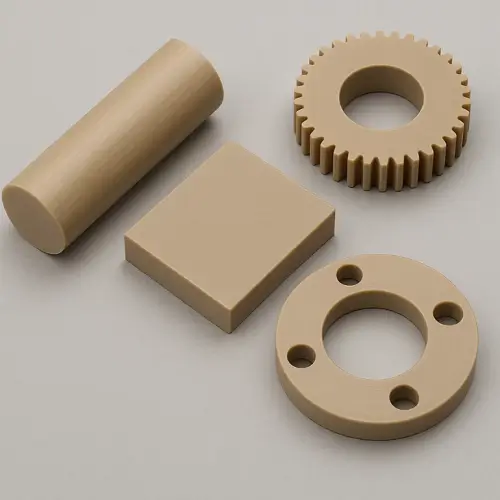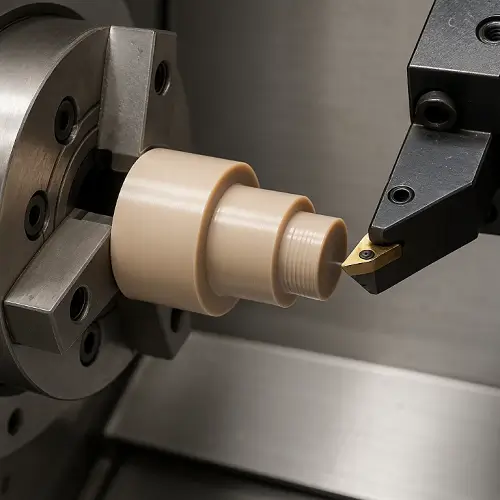In industries where failure is not an option—like aerospace, medical, and semiconductors—engineers are increasingly turning to PEEK (Polyether ether ketone) for mission-critical components. This high-performance thermoplastic delivers exceptional chemical resistance, mechanical stability, and heat tolerance, even under continuous loads and harsh conditions.
But these properties also make PEEK CNC machining anything but straightforward.
While injection molding is an option for high-volume production, many parts—especially those with tight tolerances, low production runs, or complex geometries—require subtractive manufacturing. That’s where CNC machining comes in. It offers design flexibility, prototyping agility, and precision fit that molded parts can’t always achieve.
Still, machining PEEK demands more than just tooling up a VMC and pressing “go.”
This article breaks down the challenges, best practices, and real-world DFM lessons for engineers and buyers considering PEEK for their next high-spec component.

What Is PEEK and Why Machine It?
In the medical field, PEEK (polyether ether ketone) has become one of the most trusted polymers for load-bearing implants, surgical instruments, and fluidic device housings. It’s biocompatible, radiolucent, chemically inert, and can tolerate repeated sterilization without warping or degrading.
But more importantly—it machines like no other plastic.
Unlike molded components that may require expensive tooling and compromise tolerances, CNC machining allows medical-grade PEEK parts to achieve tight fits, clean threads, and ultra-smooth sealing surfaces.
Still, it’s not easy. PEEK’s high melting point (~343 °C), low thermal conductivity, and material toughness make it prone to thermal expansion, burrs, and surface grooving if not handled properly.
This article walks through real-world machining parameters, fixturing tips, and design-for-manufacturing insights from medical projects where accuracy and reliability are non-negotiable.
Key Properties of PEEK for Machining
| Property | Value |
|---|---|
| Tensile Strength | 90–100 MPa |
| Melting Point | ~343 °C |
| Glass Transition Temp | ~143 °C |
| Thermal Conductivity | ~0.25 W/m·K |
| Max Continuous Use Temp | ~260 °C |
| Hardness (Rockwell) | M100–M120 |
| Density | ~1.3 g/cm³ |
| Modulus of Elasticity | ~3.6 GPa |
These figures vary slightly depending on the grade (unfilled, glass-filled, carbon-filled, bearing-grade), but machining parameters generally follow the same trend.
Why PEEK Is Difficult to Machine
PEEK has low thermal conductivity and high melting point. This combination means cutting generates heat that has nowhere to go—leading to thermal expansion, surface softening, and dimensional drift.
Other common issues include:
-
Burr Formation: Especially during drilling and slotting operations.
-
Edge Fracture: If feeds are too low or if the tool geometry isn’t optimized.
-
Surface Grooving: If tool sharpness drops even slightly, PEEK shows it.
PEEK also tends to absorb moisture, which expands the part microscopically and shows up as tolerance instability.
Machining Parameters: Speeds, Feeds, and Tooling
Tool Selection
-
Material: Solid carbide is a must. For extended jobs or abrasive-filled grades, diamond-like coatings help.
-
Geometry: Razor-sharp edges. Zero or minimal rake for turning, positive rake for milling.
-
Coolant: Air blast preferred. Flood coolant risks thermal shock if part is near its softening point.
Suggested Parameters
| Operation | Speed (SFM) | Feed Rate (IPR) | Notes |
|---|---|---|---|
| Turning | 250–600 | 0.002–0.008 | Light passes to control heat |
| Milling | 150–400 | 0.001–0.005 | Use climb milling |
| Drilling | 100–300 | 0.002–0.006 | Peck cycle essential |
| Tapping | – | – | Prefer thread milling |
Always run dry or use compressed air. PEEK can deform if coolant is absorbed or trapped under heat.
Tolerance and Dimensional Control in PEEK Parts
Due to thermal expansion (CTE ~47 × 10⁻⁶ /K), a PEEK part machined to ±0.01 mm at 22 °C might drift by more than ±0.03 mm in a 50 °C environment.
This matters in medical or sealing applications where dimensional creep leads to performance failure.
Tips for holding tolerances:
-
Rough first, finish after 12–24 hr stress relief (air dry or oven @ 150 °C).
-
Allow relief pockets near bosses to reduce warping.
-
Use fixture nests that spread load evenly. Clamp marks often cause deformation.
Design for Machinability (DFM): Real Considerations
Threaded PEEK Parts
Avoid creating overly fine or shallow threads. Due to low hardness and some elasticity, threads under M3 or with pitches under 0.5 mm tend to strip or deform after thermal cycling.
Engineer’s Tip :
For better thermal stability, use threaded brass inserts installed via heat staking.
If machining threads directly, prefer trapezoidal or ACME-style profiles for better engagement.
Thin Walls and Ribs
For walls under 1 mm thickness, you’re fighting against flex and local heat buildup. The part may chatter during finishing passes, leaving inconsistent surfaces.
-
Maintain minimum wall thickness >1.5 mm for standalone walls.
-
Add perpendicular ribs (min 2 mm thick) spaced every 15–20 mm for better rigidity.
-
Use full-radius inside corners to avoid stress concentration.
Burr Management
PEEK parts for medical and fluidic use must be burr-free. Manual deburring often leaves smears.
-
Use cryogenic deburring (CO₂ or N₂ blasting) for mass-produced parts.
-
For tight features, ultrasonic micro-deburring works without mechanical load.
Common Applications for CNC Machined PEEK
| Industry | Example Components |
|---|---|
| Medical | Surgical instruments, dental implants |
| Aerospace | Insulation brackets, bearing cages |
| Semiconductor | Wafer chuck components, vacuum seals |
| Oil & Gas | Downhole sensor housings, connector sleeves |
| Automotive | Lightweight wear-resistant bushings |
Each industry values PEEK for different reasons—sterilization resistance, dielectric properties, chemical inertness—but they all converge on tight tolerance expectations.
Final Thoughts: Is PEEK the Right Material for Your Machined Part?
If the part operates above 150 °C, sees chemical exposure, or needs long-term structural integrity without corrosion, then PEEK’s value justifies the machining challenge.
But machining PEEK well takes prep. You need the right tools, right geometry, a stress relief step, and proper fixturing. Trying to wing it like Delrin or ABS leads to trouble.
JeekRapid machines tight-tolerance PEEK parts daily—whether it’s a medical valve seat, a sensor housing with tight ID concentricity, or a thin-walled aerospace insulator.
Need DFM Feedback or Tolerance Guidance?
Upload your CAD or PDF and let our PEEK team review it.
We’ll flag potential tolerance risks, suggest fixture strategies, and recommend optimized toolpaths—for free.
📩 Get a detailed manufacturability report in 24h. No commitment.



